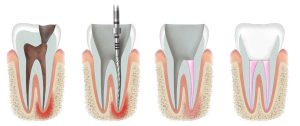Dental Clinic | Ang Mo Kio, Bedok, Jurong East, Tampines – Dental Implants & Oral Care Singapore
New risks of Root Canal treatment
New risks of Root Canal treatment

Risks and complications associated with Root Canal Treatment
Although a root canal treatment is a common thing in today’s medically advanced world, risks and complications may arise unexpectedly. You should always be aware of such things before a procedure as it is better to go in prepared. Risks and complications associated with root canal treatment include:
- Colour changes
Dental pulp, which is a living part inside each of your teeth, can become infected. If this happens, it must be removed by a root canal therapy to prevent the infection from spreading and saving your tooth from extraction. However, tooth pulp contains connective tissue, blood vessels and nerves and without it, the treated tooth can be subjected to discolouration. This is because the tooth is dead without dental pulp, and the roots may begin to show through the dentin, which does not occur frequently. In cases where it does, crowns or veneers can help to improve the appearance.
- Sinus congestion
Everything within your body is connected to one another, including your teeth. Liquid in your jaw can leak slightly through the membranes in your nose as your root canal and sinus cavity are very close to each other. While it may not be life threatening, inflammation in the sinus cavities can be irritating with headaches and congestion as the main symptoms. A continuously salty flavour in your mouth is an indication of a sinus problem caused by a root canal treatment. In most cases, the problem goes away after a few weeks.
- Reinfection
This is by far the greatest concern of any root canal patients. While reinfection is a root canal risk, your endodontist will go through numerous steps to stop this from happening. Reinfection can happen if any stage of the root canal treatment is completed incorrectly. For instance, when your dentist clean and disinfect empty root canals, which are made up of many narrow, winding branches, some of these passageways could be overlooked or inaccessible. The most common risk is a seal failure, whereby once the root canal procedure is completed, the hole used for access to the root canal will need to be resealed. Any cracks or gaps in the seal will allow bacteria to re-enter the tooth. It is also possible for a seal to erode. Permanent fillings or crowns can be used to close off the outer part of the tooth, but without the proper care, these can also wear down over time and allow bacteria to enter.
- Tooth cracking
A root canal treated tooth will not be as strong as it was before the bacterial infection and treatment. The tooth is essentially dead with all the living parts removed, making it quite brittle, as the dental pulp is to keep the tooth nourished and moisturised. Crowns are thus recommended post root canal treatment to strengthen the outer are of the tooth.
- Other complications
For a minority of patients, their surrounding nerves around the affected tooth can be affected by the root canal procedure. This may potentially cause numbness which goes away within a few weeks. Another root canal risk is an allergy to anaesthesia which is not a huge problem if your dentist is informed before the procedure.
Although risks and complications may be associated with a root canal treatment, there are still many benefits to explore. Its best to find out more about the root canal treatment before going for one. To find out your suitability, feel free to contact us at 1728 Dental via :
1728 Dental@AMK: +65 9631 1728
1728 Dental @Bedok Central: +65 8764 1728
1728 Dental@Jurong East: +65 9770 1728
1728 Dental@Tampines: +65 9725 1728
Alternatively, you may WhatsApp us at:




















